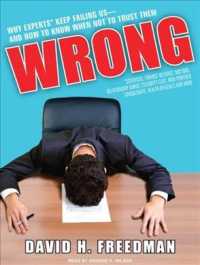- ホーム
- > 洋書
- > 英文書
- > Science / Mathematics
Full Description
Nature is full of spidery patterns: lightning bolts, coastlines, nerve cells, termite tunnels, bacteria cultures, root systems, forest fires, soil cracking, river deltas, galactic distributions, mountain ranges, tidal patterns, cloud shapes, sequencing of nucleotides in DNA, cauliflower, broccoli, lungs, kidneys, the scraggly nerve cells that carry signals to and from your brain, the branching arteries and veins that make up your circulatory system. These and other similar patterns in nature are called natural fractals or random fractals. This chapter contains activities that describe random fractals. There are two kinds of fractals: mathematical fractals and natural (or random) fractals. A mathematical fractal can be described by a mathematical formula. Given this formula, the resulting structure is always identically the same (though it may be colored in different ways). In contrast, natural fractals never repeat themselves; each one is unique, different from all others. This is because these processes are frequently equivalent to coin-flipping, plus a few simple rules. Nature is full of random fractals. In this book you will explore a few of the many random fractals in Nature. Branching, scraggly nerve cells are important to life (one of the patterns on the preceding pages). We cannot live without them. How do we describe a nerve cell? How do we classify different nerve cells? Each individual nerve cell is special, unique, different from every other nerve cell. And yet our eye sees that nerve cells are similar to one another.
Contents
1. From Coin Flipping to Motion of Molecules.- 1.1 Introduction.- 1.2. Randomness: Making Predictions Even When No One Knows What Will Happen Next.- 1.3. How Often Something Happens (Probability Distributions).- 1.4 Random Movement (Random Walks).- 1.5 Pascal's Triangle.- 1.6 Average Displacement and Average Squared Displacement.- 1.7 Diffusion.- 1.8 Periodic Precipitation: Liesegang Rings.- 1.9 Postlude: The Meaning of Models.- Appendix A Demonstration that Average Squared Displacement Is Equal to Number of Steps Taken.- Appendix B. Preparation for Liesegang Ring Experiment.- 2. Fractals in Nature. Growing and Measuring Random Fractals.- 2.1 Introduction.- 2.2. Coastline.- 2.3. The Meaning of Dimension.- 2.4. Growing Random Patterns.- 2.5. Computer Measurement of Fractal Dimension.- 2.6. Modeling the Growth of a Fractal Pattern.- 2.7. The Hele-Shaw Experiment.- 2.8 Branching Patterns Formed by Bacterial Colonies.- 2.9 Termite Nesting and Foraging in Two Dimensions.- 2.10 Fractal Root Systems.- 2.11. Research!.- Appendix A. Dimensions and Logarithms.- Appendix B. Construction of ECD and Hele-Shaw Cells.- Appendix C. Using Video Frame Grabbing.- Appendix D. Using the Scanner for Imaging.- Appendix E. Preparing the Carrageenan Solutions.- Appendix F. Using the Vernier pH Meter.- Appendix G. Preparation of Bacterial Growth Experiment.- Appendix H. Constructing the Cell for a Termite Colony.- Appendix I. Constructing Rhizotron for Root Systems.- 3. Growth Patterns in Nature: Percolation.- 3.1 Growing a Forest.- 3.2 Burning a Forest.- 4 DNA and Literature.- 4.1 DNA Sequences.- 4.2 Storing Information in DNA.- 4.3 Word Occurences and Zipf's Law.- 4.4 Landscapes of Literature and DNA.- 4.5 Discover coding regions in DNA.- A Answers to problems..- B Log-Log-paper.- C Thisand That.- 5 Spin Glasses and Neural Networks.- 5.1 Introduction.- 5.2 Magnetic Order.- 5.3 Ising Model.- 5.4 Magnetic Disorder.- 5.5 Spin Glasses.- 5.6 Hopfield Model.- 5.7 Bibliography.- 6 Lightning and Soap Films.- 6.1 Introduction.- 6.2 Electric Field.- 6.3 Electrostatics.- 6.4 Laplace Equation.- 6.5 Numerical Approach to our Main Task.- 6.6 Fractal Growth.- 6.7 Bibliography.- 7 Analyzing Rough Surfaces Digitally.- 7.1 Introduction.- 7.2 Defining the Self-Affine Surface.- 7.3 Activity: The Paper Tear Experiment.- 7.4 The Paper Tear: Understanding Experiments with Models.- 7.5 Testing the Minimal Energy Model.- 7.6 Conclusion.





